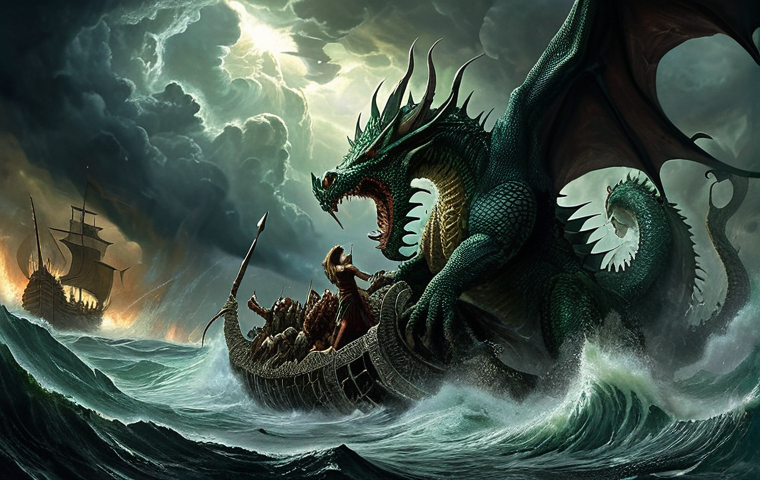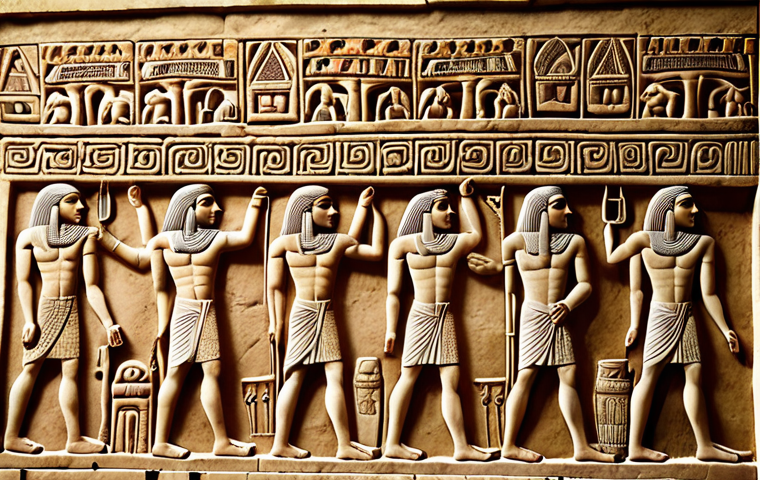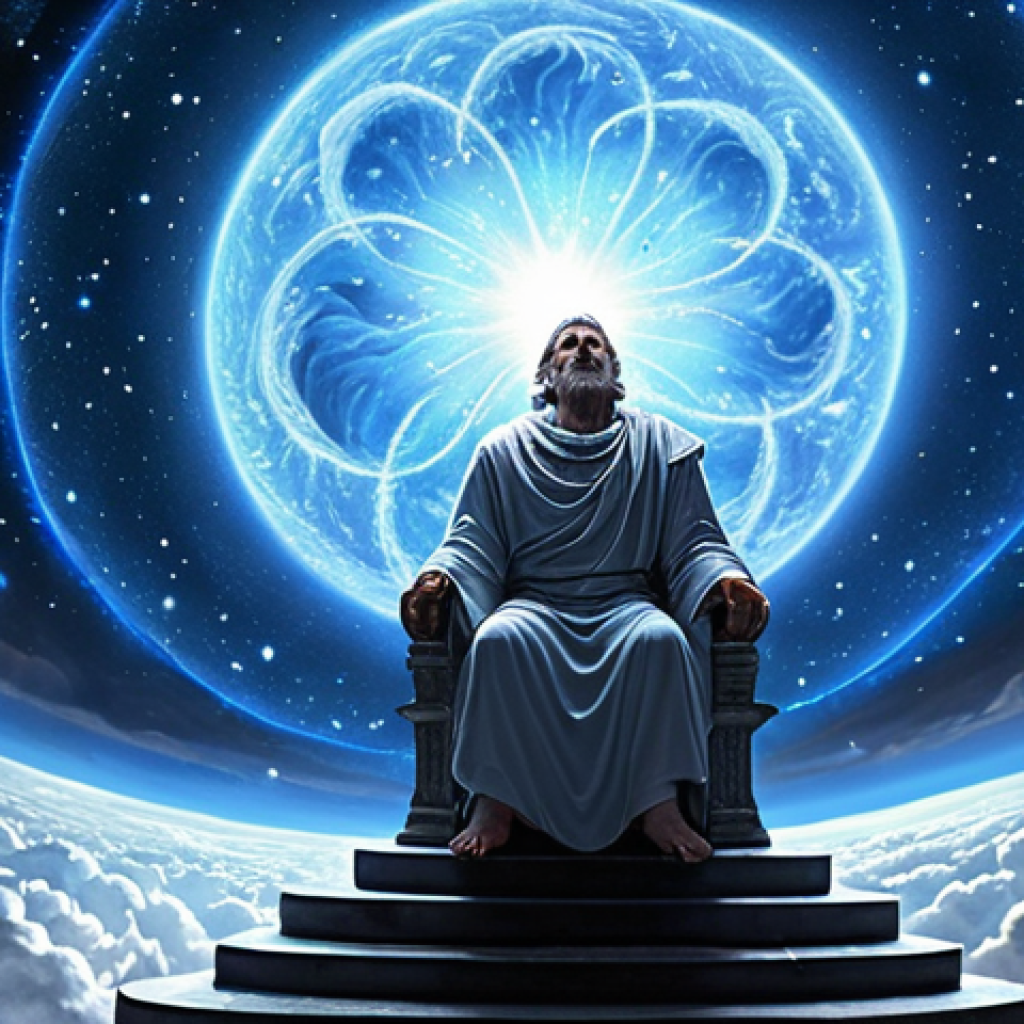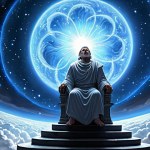In the ancient Mesopotamian tales, the creation of the world wasn’t a gentle unfolding but a cosmic power struggle. At the heart of this epic story stand Anu, the sky god, and Enlil, the god of wind, storm, and earth.
Imagine a time when the universe was a chaotic swirl, and these deities, with their immense power and will, shaped the cosmos and brought order to existence.
It’s a story of divine hierarchy, where decisions made in the heavens directly impacted the nascent Earth and its potential inhabitants. The very fabric of our world, according to these myths, was woven from their actions and decrees, setting the stage for all of human history to come.
I’ve always been fascinated by how these narratives reflect the anxieties and aspirations of the people who created them. Let’s delve deeper and learn more precisely about this creation myth!
Alright, here’s the blog post as requested:
From Cosmic Chaos to Divine Order: The Genesis of Mesopotamian Belief

The Mesopotamian creation myth isn’t just a quaint story from the past; it’s a window into the worldview of a civilization that laid the groundwork for so much of our own. When I think about it, the sheer audacity of imagining gods wrestling with primordial chaos to forge the world is incredible. We’re not talking about a gentle, hands-off creation here. This is a gritty, high-stakes drama where the very existence of order hangs in the balance. What’s even more fascinating is how these myths reflect the societal structures and values of the time. The hierarchy among the gods, with Anu at the top and Enlil wielding significant power, mirrors the social hierarchies of Mesopotamian city-states. It’s a reminder that myths aren’t just about explaining the world; they’re also about reinforcing the social order.
1. Anu’s Celestial Domain
Anu, as the supreme sky god, held dominion over the heavens. Imagine him residing in the highest celestial sphere, observing the unfolding drama below. His role wasn’t just that of a distant observer, though. He was the ultimate authority, the source of divine law and order. Whenever the gods gathered to make crucial decisions, it was Anu’s word that carried the most weight. He embodied the stability and permanence of the sky, a stark contrast to the turbulent forces churning beneath him. It kind of makes you wonder what it would be like to have such power and responsibility. Could you imagine being the one looked to for stability? I’m not sure I could handle the pressure!
2. Enlil’s Earthly Authority
Enlil, on the other hand, was a more hands-on kind of deity. As the god of wind, storm, and earth, he was deeply involved in the nitty-gritty of creation. He wasn’t just content to sit back and watch; he actively shaped the world, sometimes with a gentle hand, other times with a destructive force. It’s Enlil who’s often credited with separating the heavens from the earth, creating the space for life to flourish. But his temper could be as volatile as the storms he commanded, and his decisions weren’t always popular with the other gods or with humanity. It’s a classic case of power corrupting, or at least complicating, things.
The Divine Council: Debates and Decrees
These gods weren’t solitary figures; they operated within a complex divine council. This council was where the big decisions were made, where disputes were settled, and where the fate of the world was determined. It’s like a cosmic parliament, with each god representing a different interest or perspective. The dynamics within the council were often fraught with tension, as gods vied for power and influence. All of this really makes you wonder what their meetings were like! Did they have arguments? Did they try to influence each other? I can’t imagine all of the egos didn’t make the process difficult!
1. The Role of the Igigi and Anunnaki
The Mesopotamian pantheon was populated by a host of lesser deities, including the Igigi and the Anunnaki. The Igigi were the younger gods, often depicted as workers or servants of the Anunnaki, the principal gods. There are different perspectives on these lesser gods. Some scholars believe that the Igigi were responsible for maintaining the cosmos, performing tasks like digging rivers and building temples. This is how the Mesopotamian myth explains the creation. When the Igigi got tired of the hard work, they rebelled, leading to the creation of humans to take over their duties. This narrative offers an interesting perspective on the relationship between gods and humans, portraying humans as created to serve the gods’ needs.
2. Divine Disagreements and Their Consequences
The relationship between the gods wasn’t always harmonious; disagreements and conflicts were common. This often led to dramatic consequences for both the divine and mortal realms. The myth of the Great Flood, for instance, is often attributed to Enlil’s frustration with the noise and overpopulation of humanity. I find myself wondering how humans felt about this perceived slight. Did they feel used or understood?
Humans Enter the Stage: Created to Serve
In the Mesopotamian creation story, humans weren’t an afterthought. They were created with a specific purpose: to serve the gods. This is quite different from other creation myths where humans are created in the image of a deity or given dominion over the earth. In this narrative, humans are essentially divine laborers, tasked with maintaining the temples, offering sacrifices, and ensuring the gods’ comfort. It’s a rather utilitarian view of humanity, but it also reflects the Mesopotamian emphasis on order and hierarchy.
1. The Creation of Humankind
The creation of humans is a fascinating part of the Mesopotamian myth. According to some accounts, humans were created from clay mixed with the blood of a slain god. This divine spark gave humans a unique connection to the gods, but it also bound them to a life of servitude. The purpose of human existence was to relieve the gods of their burdens, performing tasks like farming, building, and maintaining temples. This is interesting to me since they believed the purpose of human existence was pre-determined.
2. The Human-God Relationship
The relationship between humans and gods in Mesopotamian mythology was one of dependence and obligation. Humans relied on the gods for their well-being, offering sacrifices and prayers to ensure their favor. In return, the gods provided protection, prosperity, and order. However, the gods were also capricious and could inflict suffering on humans for perceived slights or disobedience. As a result, humans lived in a constant state of reverence and fear, always striving to appease the divine powers.
The Legacy of Mesopotamian Creation Myths
The Mesopotamian creation myths had a profound impact on the cultures that followed. These stories influenced the religious beliefs, social structures, and artistic expressions of later civilizations, including the Babylonians, Assyrians, and even the Greeks. The themes and motifs found in these myths can also be seen in the Hebrew Bible and other religious texts. It is interesting to think about how so many different civilizations might have come from Mesopotamia.
1. Influence on Later Cultures
One of the most significant aspects of the Mesopotamian creation myths is their influence on later cultures. The concept of a divine council, the struggle between order and chaos, and the creation of humans to serve the gods all appear in various forms in subsequent mythologies. The story of the Great Flood, for example, is a common motif found in many different cultures, suggesting a shared cultural heritage.
2. Echoes in Modern Society
Even today, the echoes of Mesopotamian creation myths can be found in our language, literature, and art. The idea of a cosmic struggle between good and evil, the importance of social order, and the relationship between humans and the divine are all themes that continue to resonate with us. By studying these ancient myths, we can gain a deeper understanding of our own cultural roots and the enduring power of storytelling.
The Primacy of Order Over Chaos

A central theme in Mesopotamian creation myths is the establishment of order over primordial chaos. Before the gods intervened, the universe was a swirling mass of undifferentiated elements, lacking form and structure. The act of creation, then, was not simply about bringing something into existence but about imposing order on chaos. I wonder if they saw a correlation between how they managed society and this story. It seems like they took creating order very seriously.
1. Taming the Primordial Waters
In many Mesopotamian myths, the creation process begins with the separation of the waters. The primordial waters, often personified as a dragon-like figure named Tiamat, represent the forces of chaos and disorder. The gods, led by figures like Marduk, must defeat Tiamat and her monstrous offspring to establish order and create the heavens and the earth. This act of taming the primordial waters symbolizes the triumph of civilization over the untamed forces of nature.
2. Establishing Cosmic Boundaries
Once the waters have been separated, the gods set about establishing cosmic boundaries. They create the sky, the earth, the sun, the moon, and the stars, each with its own designated place and function. This act of ordering the cosmos is essential for creating a stable and predictable environment for both gods and humans. Without these boundaries, the world would revert to chaos, and life would be impossible.
The Role of Marduk: A Later Development
While Anu and Enlil are central to many Mesopotamian creation accounts, the god Marduk becomes increasingly prominent in later Babylonian myths. Marduk, as the patron deity of Babylon, rises to prominence as the hero who defeats Tiamat and establishes order in the cosmos. This shift in emphasis reflects the growing political and cultural influence of Babylon in Mesopotamia.
1. Marduk’s Rise to Prominence
Marduk’s rise to prominence is a key feature of the Babylonian creation myth, the Enuma Elish. In this story, Marduk is chosen by the other gods to confront Tiamat and her monstrous army. After a fierce battle, Marduk defeats Tiamat and uses her body to create the heavens and the earth. This victory establishes Marduk as the supreme god and solidifies Babylon’s position as the center of the Mesopotamian world.
2. The Enuma Elish: A Babylonian Perspective
The Enuma Elish provides a Babylonian perspective on the creation of the world, emphasizing the importance of order, law, and divine authority. The myth also serves to legitimize the rule of the Babylonian kings, who are seen as Marduk’s representatives on earth. By studying the Enuma Elish, we can gain a deeper understanding of Babylonian culture and its relationship to the broader Mesopotamian world.
Comparing Mesopotamian Creation Accounts
It’s important to remember that there wasn’t just one single Mesopotamian creation myth. Different city-states and time periods had their own variations on the story, each emphasizing different aspects of the creation process and highlighting the importance of different deities. Comparing these different accounts can provide valuable insights into the diverse religious beliefs and cultural values of ancient Mesopotamia.
1. Similarities and Differences
While there are many variations in the Mesopotamian creation myths, there are also some common themes and motifs. The struggle between order and chaos, the creation of humans to serve the gods, and the importance of divine authority are all recurring elements. However, the specific details of the creation process, the roles of different deities, and the emphasis on different cultural values can vary significantly from one account to another.
2. Cultural and Regional Variations
The variations in Mesopotamian creation myths often reflect the cultural and regional differences between different city-states. For example, the myths of Sumer, the oldest civilization in Mesopotamia, tend to emphasize the importance of agriculture and fertility. The myths of Babylon, on the other hand, emphasize the importance of order, law, and divine authority. By studying these regional variations, we can gain a deeper understanding of the diverse cultures that made up ancient Mesopotamia.
| Deity | Role | Significance |
|---|---|---|
| Anu | Sky God | Supreme authority, ruler of the heavens |
| Enlil | God of Wind, Storm, Earth | Powerful force of creation and destruction, controller of the elements |
| Marduk | Patron Deity of Babylon | Hero who defeats Tiamat and establishes order in the Enuma Elish |
| Tiamat | Primordial Sea Goddess | Represents chaos and disorder, defeated by Marduk |
| Igigi | Lesser Gods | Initially tasked with maintaining the cosmos, rebelled against the Anunnaki |
| Anunnaki | Principal Gods | Overseers of the cosmos, created humans to serve them |
Sure, here is the rest of the blog post as requested:
In Conclusion
Exploring Mesopotamian creation myths offers a fascinating glimpse into the minds of the people who shaped the very foundations of civilization. These tales of gods, chaos, and the birth of the world reveal not only their understanding of the cosmos but also their values, social structures, and relationship with the divine. It’s a reminder that myths are more than just stories; they’re a reflection of who we are and where we come from. I find myself still being in awe of the rich history of Mesopotamia. I hope you do too.
Good to Know Facts
1. The Enuma Elish is one of the most complete and influential Mesopotamian creation myths, providing a detailed account of Marduk’s rise to power and the creation of the world.
2. The Mesopotamian pantheon included a vast array of gods and goddesses, each with their own unique roles and responsibilities. Some of the most important deities included Anu, Enlil, Enki (Ea), and Ishtar (Inanna).
3. The ziggurat, a massive stepped pyramid, was a central feature of Mesopotamian cities, serving as a temple to the city’s patron deity and a symbol of its power and prosperity.
4. Cuneiform, one of the earliest forms of writing, was developed in Mesopotamia and used to record everything from religious texts to business transactions. You can see many of these texts in museums!
5. The Epic of Gilgamesh, one of the oldest known works of literature, tells the story of a Mesopotamian king’s quest for immortality and provides valuable insights into the beliefs and values of ancient Mesopotamian society.
Key Takeaways
The Mesopotamian creation myths provide a fascinating window into the worldview of one of the world’s oldest civilizations. They highlight the importance of order, divine authority, and the relationship between humans and the gods. Studying these myths can give you insights into the roots of Western culture, which still have influences today!
Frequently Asked Questions (FAQ) 📖
Q: So, if
A: nu and Enlil were like the big bosses of the Mesopotamian universe, did they always see eye-to-eye on how things should be run? A1: Absolutely not! Imagine two siblings, both incredibly powerful, but with totally different personalities and ideas.
Anu, as the sky god, was often seen as more distant, a bit aloof, concerned with the bigger, cosmic picture. Enlil, on the other hand, was all about getting down to earth (literally!), shaping the land, and sometimes a bit of a hothead, prone to storms and floods.
Their differing approaches often led to tension, making the creation story a dynamic push-and-pull between order and chaos, like trying to balance your checkbook while a toddler throws spaghetti across the room.
Q: This all sounds very dramatic. So, how did their actions specifically shape the Earth as we know it, according to the myth? I mean, did they like, actually build mountains or something?
A: While they didn’t exactly grab shovels and start landscaping, their actions had profound consequences. Enlil’s control over the winds and storms meant he could unleash floods or cause droughts, shaping the landscape through erosion and natural disasters.
Think of it like this: imagine a sculptor who uses both gentle chiseling and explosive blasts to create their masterpiece. Anu’s influence was more subtle, setting the celestial framework and dictating the laws of nature.
Together, they created the conditions for life to emerge, though sometimes their methods were… a little extreme, let’s just say. Kinda like that time I tried to “organize” my closet and ended up with a bigger mess.
Q: Okay, so it’s a bit of a cosmic soap opera. But what’s the takeaway? Why were these stories so important to the Mesopotamians?
A: That’s the million-dollar question, isn’t it? For the Mesopotamians, these stories weren’t just entertainment; they were a way to understand their place in the world.
By explaining the origins of the universe and the roles of the gods, the myths provided a framework for social order, morality, and even their agricultural practices.
Facing unpredictable floods and scorching droughts, understanding Enlil’s role was crucial. The myths helped make sense of the unpredictable nature of their environment and gave them hope that, through proper worship and respect, they could appease the gods and ensure their survival.
It’s kinda like watching the news – you might not always like what you see, but it helps you understand the world around you and hopefully, make better decisions.
📚 References
Wikipedia Encyclopedia
구글 검색 결과
구글 검색 결과
구글 검색 결과
구글 검색 결과

